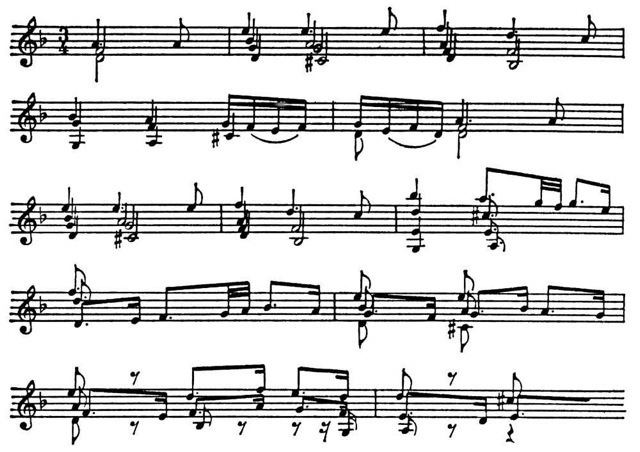 | ||
The Partita in D minor for solo violin (BWV 1004) by Johann Sebastian Bach was written between 1717 and 1720. It is a part of his compositional cycle called Sonatas and Partitas for Solo Violin.
Contents
Structure
The partita contains five movements, given in Italian as:
- Allemanda
- Corrente
- Sarabanda
- Giga
- Ciaccona
The movements correspond to the dances of the time, and they are frequently listed by their French names: Allemande, Courante, Sarabande, Gigue, and Chaconne. The final movement is written in the form of variations, and lasts approximately as much time as first four movements combine.
Performance time of the whole partita varies between 26 and 32 minutes, depending on the approach and style of the performer.
Interesting facts
Professor Helga Thoene suggests that this partita, and especially its last movement, was a tombeau written in memory of Bach's first wife, Maria Barbara Bach (who died in 1720), though this theory is controversial.
Yehudi Menuhin called the Chaconne "the greatest structure for solo violin that exists".
Violinist Joshua Bell has said the Chaconne is "not just one of the greatest pieces of music ever written, but one of the greatest achievements of any man in history. It's a spiritually powerful piece, emotionally powerful, structurally perfect." He played the piece busking in L'Enfant Plaza for The Washington Post.
Piano transcriptions
Since Bach's time, several transcriptions of the piece have been made for other instruments, particularly for the piano (by Ferruccio Busoni and Joachim Raff), and for the piano left-hand (by Brahms).
Johannes Brahms, in a letter to Clara Schumann in June 1877, said about the ciaccona:
On one stave, for a small instrument, the man writes a whole world of the deepest thoughts and most powerful feelings. If I imagined that I could have created, even conceived the piece, I am quite certain that the excess of excitement and earth-shattering experience would have driven me out of my mind.
Felix Mendelssohn and Robert Schumann each wrote piano accompaniments for the work.
Organ transcriptions
The earliest version for organ is by William Thomas Best. Further transcriptions are by John Cook, Wilhelm Middelschulte, Walter Henry Goss-Custard (1915–55), and Henri Messerer (1838–1923).
In the preface to his 1955 transcription, John Cook writes: "The Chaconne is sublimely satisfying in its original form, yet many will agree that a single violin is only able to hint at the vast implications of much of this music … It is perhaps not unreasonable to suppose that Bach would have chosen the organ, had he transcribed the Chaconne himself, as the instrument best suited to the scale of his ideas … A good performance on the violin may be taken as the best guide to interpretation on the organ — the two instruments are not without their points in common, and both were beloved of Bach."
Cello transcriptions
There is a transcription of the Chaconne for solo cello made by cellist Johann Sebastian Paetsch in 2015. This has been published by the Hofmeister Musikverlag in Leipzig.
Guitar transcriptions
The Chaconne is often performed on guitar. Marc Pincherle, Secretary of the French Society of Musicology in Paris, wrote in 1930: "If, insofar as certain rapid monodic passages are concerned, opinion is divided between the violin and the guitar as the better medium, the guitar always triumphs in polyphonic passages; that is to say almost throughout the entire work. The timbre of the guitar creates new and emotional resonance and unsuspected dynamic gradations in those passages which might have been created purely for the violin; as for instance the variations in arpeggi."
The most well-known transcription for guitar is the Segovia transcription. Many guitarists today prefer to play the Chaconne directly from the violin score.
Orchestra transcriptions
There are a number of transcriptions of the Chaconne for orchestras of different sizes, including Leopold Stokowski's transcription for a full symphony orchestra.
Literature
In 2005 Joseph C. Mastroianni published Chaconne The Novel. Milo, abandoned by the father who introduced him to Chaconne, studies in Spain for four years to master the piece.
In 2008 Arnold Steinhardt, the violin soloist and first violinist of the Guarneri String Quartet published Violin Dreams, a memoir about his life as a violinist and about his ultimate challenge: playing Bach's Chaconne.
